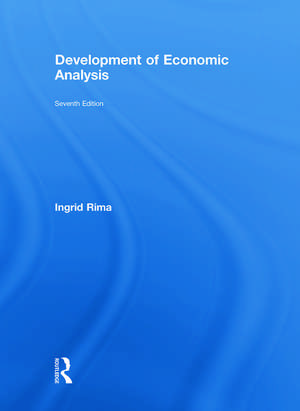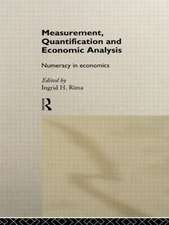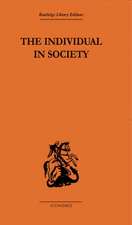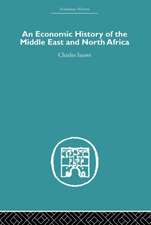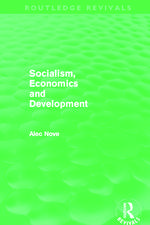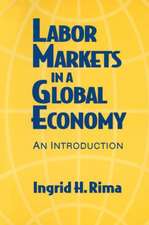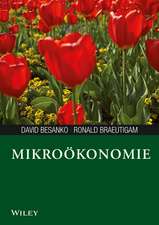Development of Economic Analysis
Autor Ingrid H. Rimaen Limba Engleză Hardback – 23 dec 2008
The book then goes on to offer extensive coverage of the twentieth century - the rise of Keynesianism, econometrics, the Chicago School and the neoclassical paradigm. The concluding chapters analyze the birth of late twentieth century developments such as game theory, experimental economics and competing schools of economic thought.
This text includes a number of practical features:
- a "family tree" at the beginning of each section, illustrating how the different developments within economics are interlinked
- the inclusion of readings from the original key texts
- a summary and questions to discuss, along with glossaries and suggestions for further reading
| Toate formatele și edițiile | Preț | Express |
|---|---|---|
| Paperback (1) | 664.63 lei 43-57 zile | |
| Taylor & Francis – 23 dec 2008 | 664.63 lei 43-57 zile | |
| Hardback (1) | 946.62 lei 43-57 zile | |
| Taylor & Francis – 23 dec 2008 | 946.62 lei 43-57 zile |
Preț: 946.62 lei
Preț vechi: 1262.53 lei
-25% Nou
Puncte Express: 1420
Preț estimativ în valută:
181.14€ • 189.60$ • 150.76£
181.14€ • 189.60$ • 150.76£
Carte tipărită la comandă
Livrare economică 31 martie-14 aprilie
Preluare comenzi: 021 569.72.76
Specificații
ISBN-13: 9780415772938
ISBN-10: 0415772931
Pagini: 618
Ilustrații: 47 b/w images, 7 tables and 47 line drawings
Dimensiuni: 174 x 246 mm
Greutate: 1.31 kg
Ediția:7
Editura: Taylor & Francis
Colecția Routledge
Locul publicării:Oxford, United Kingdom
ISBN-10: 0415772931
Pagini: 618
Ilustrații: 47 b/w images, 7 tables and 47 line drawings
Dimensiuni: 174 x 246 mm
Greutate: 1.31 kg
Ediția:7
Editura: Taylor & Francis
Colecția Routledge
Locul publicării:Oxford, United Kingdom
Public țintă
Postgraduate and UndergraduateCuprins
Part 1: Preclassical Economics, 1. Early Masterworks as a source of Economic Thought, 2. The Origins of Analytic Economics 3. The Transition to Classical Economics, Part II: Classical Economics, 4. Physiocracy: The Beginning of Analytical Economics, 5. Adam Smith: From Moral Philosophy to Political Economy, 6. Thomas Malthus and J. B. Say: The Political Economy of Population Behaviour and Aggregate Demand, 7. David Ricardo: Economic Analysis of the Distributive Shares, 8. Building on Ricardian Foundations: The Mills, W. N. Senior and Charles Babbage, 9. Classical Theory in Review, Part III: The Critics of Classicism. 10. Socialism, Induction, and the Forerunners of Marginalism, 11. Karl Marx: An Inquiry into the "Law of Motion" of the Capitalist System, 12. First-Generation Marginalists: Jevons, Walras and Menger, 13. Second-Generation Marginalists, Part IV: The Neo-classical Tradition, 1980-1945, 14. Alfred Marshall and the Neo-classical Tradition, 15. Chamberlain, Robinson and Other Price Theorists, 16. The "New" Theory of Welfare and Consumer Behavior, 17. Neo-classical Monetary and business-Cycle Theorists, Part V: The Dissent form Neo-classicism, 1890-1945, 18. The Dissent of American Institutionalists, 19. The Economics of Planning: Socialism without Marxism, 20. J. M. Keynes’s Critique of the Mainstream Tradition, 21. Keynes's Theory of Employment, Output and Income, Part VI: Beyond High Theory, 22. The Emergence of Econometrics as a Sister-Discipline of Economics, 23. Neo-Keynesians, Neo-Walrasians and Monetarists, 24. The Analytics of Economic Liberalism: The Theory of Choice, Part VII: Competing Economic Paradigms, 25. From Economic Heterodoxy to Pluralism and the Revival of Political Economy
Notă biografică
Ingrid Rima is Professor of Economics at Temple University, Philadelphia, USA.
Descriere
Now in its seventh edition, Ingrid Rima's classic textbook charts the development of economics from the classical age, through the middle ages, to the era of classical economics; from the twentieth century to the present day. This is the clearest, most readable guide to economic thought, encouraging students to examine the relevance of the discipline's history to contemporary theory.
